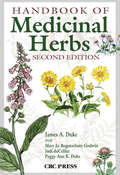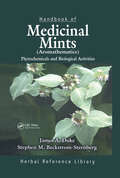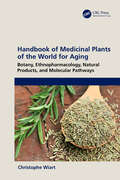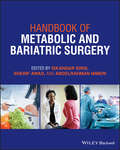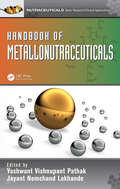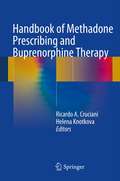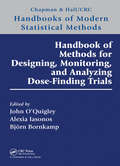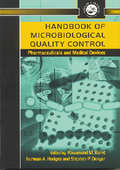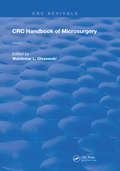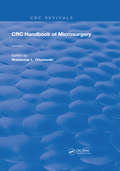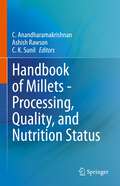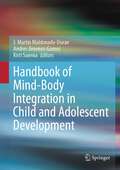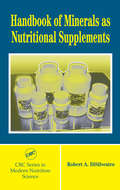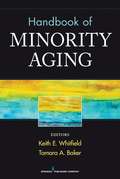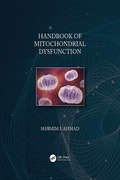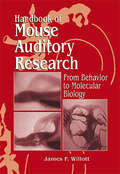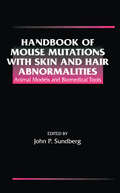- Table View
- List View
Handbook of Medical and Healthcare Technologies
by Borko Furht Ankur AgarwalThis book equips readers to understand a complex range of healthcare products that are used to diagnose, monitor, and treat diseases or medical conditions affecting humans. The first part of the book presents medical technologies such as medical information retrieval, tissue engineering techniques, 3D medical imaging, nanotechnology innovations in medicine, medical wireless sensor networks, and knowledge mining techniques in medicine. The second half of the book focuses on healthcare technologies including prediction hospital readmission risk, modeling e-health framework, personal Web in healthcare, security issues for medical records, and personalized services in healthcare. The contributors are leading world researchers who share their innovations, making this handbook the definitive resource on these topics. Handbook of Medical and Healthcare Technologies is intended for a wide audience including academicians, designers, developers, researchers and advanced-level students. It is also valuable for business managers, entrepreneurs, and investors within the medical and healthcare industries.
Handbook of Medicinal Herbs
by James A. DukeStill considered the definitive work on medicinal herbs and their uses after two decades, the Handbook of Medicinal Herbs has undergone a long-anticipated revision. In the second edition, world-renowned ethnobotanist James A. Duke provides up-to-date data on over 800 of the world's most important medicinal plant species. The book contains mo
Handbook of Medicinal Mints ( Aromathematics): Phytochemicals and Biological Activities, Herbal Reference Library
by James A. Duke Stephen M Beckstrom-SternbergThis handbook provides the most complete collection of chemical data available on aromatic mints (Lamiaceae). The authors thoroughly introduce the field of aromathematics. Handbook of Medicinal Mints (Aromatics): Phytochemicals and Biological Activities contains a wealth of quantitative data, including more than 500 references on 10,839 chemicals from 251 assays of 205 unique taxa, combined with 3,324 biological activities and 256 recommended daily allowances and lethal doses. An exhaustive guide, the handbook is the ultimate resource for assessing the potential medicinal value of a particular species.
Handbook of Medicinal Plants of the World for Aging: Botany, Ethnopharmacology, Natural Products, and Molecular Pathways
by Christophe WiartHandbook of Medicinal Plants of the World for Aging: Botany, Ethnopharmacology, Natural Products, and Molecular Pathways provides an unprecedented comprehensive overview of more than 100 plants used globally as medicine with the potential to prevent premature aging. This handbook covers the pathophysiology of aging from the molecular and cellular to the organ levels, as well as the current state of knowledge about the modes of action of natural products from plants on the pathophysiological pathways related to the (i) cardiovascular system and metabolism, (ii) central nervous system, (iii) kidneys, (iv) bones, (v) skin and hair, and (vi) immune system. Medicinal plants are presented alphabetically. For each plant is indicated the botanical family, synonyms, and common names in English, French, German, Portuguese, Russian, and Spanish. For each plant, the reader will also find the part used, active principles, medical history, contemporary medicinal uses, as well as pharmacological, clinical, and toxicological studies. The bibliographical references have been carefully selected for their relevance. This handbook is intended for medical doctors, nurses, pharmacists, dieticians, and nutritionists, as well as readers with interest in health food and herbs. FEATURES• Alphabetical presentation of over 100 medicinal plants and the pharmacological rationales for their uses for aging• Discusses the medical history, current medicinal uses, and potential candidates for the prevention of premature aging• Introduces the molecular mechanism of natural products on the pathophysiology of aging• Contains a selection of bibliographic references• A useful research tool for postgraduates, academics, and the pharmaceutical, herbal, or nutrition industries Handbook of Medicinal Plants of the World for Aging: Botany, Ethnopharmacology, Natural Products, and Molecular Pathways presents comment sections that invite further research and reflection on the fascinating and timely subject of herbals for healthy aging. This is an ideal reference text for medicinal plant enthusiasts.
Handbook of Mental Health Nursing
by Diane Carpenter Joanne Brown Stephen TeeA concise and user-friendly guide, Handbook of Mental Health Nursing helps nursing students learn the essential skills required for practice. This practical handbook is informed by an interdisciplinary understanding of mental health problems and the recovery from mental health difficulties. Features:Highlights case studies and draws on narrati
Handbook of Mental Health and Acculturation in Asian American Families
by Kathy Marie Sanders Francis G. Lu Yanni Chun Rho Nhi-Ha TrinhAsian Americans are the fastest growing minority group in the United States. When Asian immigrants arrive in the United States, they regularly encounter a vast number of difficulties integrating themselves into their new culture. In Handbook of Mental Health and Acculturation in Asian American Families, distinguished researchers and clinicians discuss the process of acculturation for individuals and their families, addressing the mental health needs of Asian Americans and thoroughly examining the acculturative process, its common stressors, and characteristics associated with resiliency. This first-of-its-kind, multi-dimensional title synthesizes current acculturation research, while presenting those concepts within a clinical framework. In addition to providing an in-depth look at both past and present research and offering directions for future topics to explore, the book also offers a range of practical tools such as research scales to measure levels of acculturation, interview techniques, and clinical approaches for special populations including children, the elderly, and their families. Thought-provoking and informative, Handbook of Mental Health and Acculturation in Asian American Families will enhance the understanding of the clinical and sociocultural problems Asian Americans face, providing clinicians with all the necessary insights to better care for their patients.
Handbook of Metabolic and Bariatric Surgery
by Iskandar Idris Sherif Awad Abdelrahman NimeriHANDBOOK OF METABOLIC AND BARIATRIC SURGERY Discover the essentials involved in the management of metabolic and bariatric surgery in this easy-to-read and well-illustrated guide The management of severe obesity and its related co-morbidities, including diabetes, has become one of the most important aspects of modern medicine. The most effective and lasting treatment for these conditions is bariatric and metabolic surgery, which has become more in demand from patients and doctors. Since many non-surgical specialists contribute to treating these patients, there is an increasing need for medical professionals to develop a working knowledge of patient requirements surrounding these operations. Handbook of Metabolic and Bariatric Surgery provides a concise, accessible guide to the management of bariatric and metabolic surgery patients. It approaches its subject from both endocrine and surgical perspectives, covering pre-, peri- and post-operative requirements for commonly undertaken surgical procedures, as well as guidance for managing metabolic, psychological, and surgical aspects. It promises to become a valuable guide to this increasingly important field. Handbook of Metabolic and Bariatric Surgery readers will also find: Over 150 full-color images and illustrations; A thorough introduction to the subject of obesity medicine and the history of bariatric and metabolic surgery; An editorial team with both research and practical clinical experience. Handbook of Metabolic and Bariatric Surgery is a useful reference for any non-surgical medical professional or researcher working within the field of obesity medicine and surgery.
Handbook of Metal-Microbe Interactions and Bioremediation
by Surajit Das Hirak Ranjan DashAround the World, metal pollution is a major problem. Conventional practices of toxic metal removal can be ineffective and/or expensive, delaying and exacerbating the crisis. Those communities dealing with contamination must be aware of the fundamentals advances of microbe-mediated metal removal practices because these methods can be easily used and require less remedial intervention. This book describes innovations and efficient applications for metal bioremediation for environments polluted by metal contaminates.
Handbook of Metallonutraceuticals (Nutraceuticals)
by Yashwant Vishnupant Pathak Jayant Nemchand LokhandeThe nutritional and medicinal value of metals, such as zinc, calcium, and iron, has been known in traditional medicine for a long time. Other metals, such as silver and gold, may also have therapeutic and health benefits. Ancient medicines have long incorporated their use in the treatment of diseases, and they have also more recently been explored
Handbook of Metastatic Breast Cancer
by Charles Swanton Stephen R. D. JohnstonRecent developments with novel systemic drugs, palliative surgical techniques and diagnostic imaging have given hope for the treatment of patients whose breast cancer has spread beyond its primary tumour. Written by a team from leading cancer centers in Europe, including the UK's Royal Marsden Hospital, the Handbook of Metastatic Breast Cancer, Sec
Handbook of Methadone Prescribing and Buprenorphine Therapy
by Helena Knotkova Ricardo A. CrucianiMethadone and buprenorphine are the only two opioids that are indicated for the management of both pain and opioid-related drug addiction. Both present unique challenges to the general practitioner and pain specialist, requiring a separate analysis from the rest of the drugs in the same family. Handbook of Methadone Prescribing and Buprenorphine Therapy is an invaluable guide to the safe use of these opioids. Authored by clinical and academic leaders from a variety of settings and backgrounds, this book includes chapters on pharmacology, adverse effects, safe rotation from other opioids, cardiac toxicity, prescribing, pharmacokinetics, equianalgesic dose, and replacement therapy. This comprehensive text provides clinicians, researchers, policy-makers and academicians a resource for all the relevant points in methadone prescribing and buprenorphine therapy.
Handbook of Methods for Designing, Monitoring, and Analyzing Dose-Finding Trials
by Alexia Iasonos Björn Bornkamp John O'QuigleyHandbook of Methods for Designing, Monitoring, and Analyzing Dose-Finding Trials gives a thorough presentation of state-of-the-art methods for early phase clinical trials. The methodology of clinical trials has advanced greatly over the last 20 years and, arguably, nowhere greater than that of early phase studies. The need to accelerate drug development in a rapidly evolving context of targeted therapies, immunotherapy, combination treatments and complex group structures has provided the stimulus to these advances. Typically, we deal with very small samples, sequential methods that need to be efficient, while, at the same time adhering to ethical principles due to the involvement of human subjects. Statistical inference is difficult since the standard techniques of maximum likelihood do not usually apply as a result of model misspecification and parameter estimates lying on the boundary of the parameter space. Bayesian methods play an important part in overcoming these difficulties, but nonetheless, require special consideration in this particular context. The purpose of this handbook is to provide an expanded summary of the field as it stands and also, through discussion, provide insights into the thinking of leaders in the field as to the potential developments of the years ahead. With this goal in mind we present: An introduction to the field for graduate students and novices A basis for more established researchers from which to build A collection of material for an advanced course in early phase clinical trials A comprehensive guide to available methodology for practicing statisticians on the design and analysis of dose-finding experiments An extensive guide for the multiple comparison and modeling (MCP-Mod) dose-finding approach, adaptive two-stage designs for dose finding, as well as dose–time–response models and multiple testing in the context of confirmatory dose-finding studies.? John O’Quigley is a professor of mathematics and research director at the French National Institute for Health and Medical Research based at the Faculty of Mathematics, University Pierre and Marie Curie in Paris, France. He is author of Proportional Hazards Regression and has published extensively in the field of dose finding. Alexia Iasonos is an associate attending biostatistician at the Memorial Sloan Kettering Cancer Center in New York. She has over one hundred publications in the leading statistical and clinical journals on the methodology and design of early phase clinical trials. Dr. Iasonos has wide experience in the actual implementation of model based early phase trials and has given courses in scientific meetings internationally. Björn Bornkamp is a statistical methodologist at Novartis in Basel, Switzerland, researching and implementing dose-finding designs in Phase II clinical trials. He is one of the co-developers of the MCP-Mod methodology for dose finding and main author of the DoseFinding R package. He has published numerous papers on dose finding, nonlinear models and Bayesian statistics, and in 2013 won the Royal Statistical Society award for statistical excellence in the pharmaceutical industry. ? ?
Handbook of Microbiological Quality Control in Pharmaceuticals and Medical Devices (Pharmaceutical Science Ser.)
by Norman A. Hodges Stephen P. Denyer Rosamund M. BairdMicrobiologists working in both the pharmaceutical and medical device industries, face considerable challenges in keeping abreast of the myriad microbiological references available to them, and the continuously evolving regulatory requirements. The Handbook of Microbiological Quality Control provides a unique distillation of such material, by provi
Handbook of Microsurgery: Volume 1 (Routledge Revivals #1)
by Waldemar L. OlszewskiPublished in 1984: The premise upon which this book was written was that only and exclusively personal experience in microsurgical operations and their effects on tissue or organ function could be presented.
Handbook of Microsurgery: Volume 2 (Routledge Revivals)
by Waldemar L. OlszewskiPublished in 1984: The premise upon which this book was written was that only and exclusively personal experience in microsurgical operations and their effects on tissue or organ function could be presented.
Handbook of Millets - Processing, Quality, and Nutrition Status
by C. Anandharamakrishnan Ashish Rawson C. K. SunilThe book offers an updated perspective on the unique characteristics of millets. Millets are consumed for their health/nutritional benefits, and in the preparation of specialty foods for target groups – from pediatrics to geriatrics. Recent trends suggest the importance of millet in the human diet due to their nutritional importance, ability to grow in high temperatures and drought conditions, and their resistance to pests and diseases. This book highlights different types of millet and discusses their properties as well as nutritional and anti-nutritional values. In addition, the book also provides information on the physiochemical properties, future prospects, current methodologies, and agricultural practices. The last few parts cover the emerging technologies in millet processing, by-products utilization, quality standards, and the current millet industry scenario. The book provides a comprehensive overview of the status of millet processing, quality, and nutraceutical product manufacture. The book is a resourceful read for students and researchers in food sciences, as well as industry experts.
Handbook of Mind/Body Integration in Child and Adolescent Development
by J. Martin Maldonado-Duran Andres Jimenez-Gomez Kirti SaxenaThe Handbook of Mind/Body Integration in Child and Adolescent Development examines issues relating to the mind/body connection in the development of children and adolescents, addressing problems of adverse life experiences with clinical implications, including somatization, functional or unexplained medical disturbances in various organ systems, psychosomatic conditions, and the effects. It discusses the interactions of emotions, experiences, thoughts in the mind – and their manifestations in the body – of children and youth. The book describes the effects of bodily conditions on the emotional state and mental functioning of children, such as cerebral palsy, major medical conditions, and other chronic health problems. It also explores the effects of chronic stress as well as child neglect and abuse on bodily manifestations.Key areas of coverage include:Developmental issues in the embodiment of self and body image in children and adolescents.Trauma and mind/body consequences in children and adolescents.Munchausen syndrome by proxy.Unexplained medical conditions, somatoform disorders, and conversion disorders during childhood and adolescence, including unexplained conditions in different organ systems (e.g., gastrointestinal, dermatological, neurological).Body/mind conditions in youth with physical and intellectual disabilities and chronic or severe medical conditions, including palliative care.Complementary and alternative treatment approaches to mind/body issues in children and adolescents, supplementing the usual mental health interventions.The Handbook of Mind/Body Integration in Child and Adolescent Psychiatry is an essential resource for researchers, professors, and graduate students as well as clinicians, therapists, and related professionals in developmental psychology, child and adolescent psychiatry, family therapy, social work, pediatrics, and public health.
Handbook of Mindfulness: Culture, Context, and Social Engagement (Mindfulness in Behavioral Health)
by David Forbes Adam Burke Ronald E. PurserThis handbook explores mindfulness philosophy and practice as it functions in today’s socioeconomic, cultural, and political landscape. Chapters discuss the many ways in which classic concepts and practices of mindfulness clash, converge, and influence modern theories and methods, and vice versa. Experts across many disciplines address the secularization and commercialization of Buddhist concepts, the medicalizing of mindfulness in therapies, and progressive uses of mindfulness in education. The book addresses the rise of the, “mindfulness movement”, and the core concerns behind the critiques of the growing popularity of mindfulness. It covers a range of dichotomies, such as traditional versus modern, religious versus secular, and commodification versus critical thought and probes beyond the East/West binary to larger questions of economics, philosophy, ethics, and, ultimately, meaning.Featured topics include:A compilation of Buddhist meditative practices.Selling mindfulness and the marketing of mindful products.A meta-critique of mindfulness critiques - from McMindfulness to critical mindfulnessMindfulness-based interventions in clinical psychology and neuroscience.Corporate mindfulness and usage in the workplace.Community-engaged mindfulness and its role in social justice.The Handbook of Mindfulness is a must-have resource for clinical psychologists, complementary and alternative medicine professionals/practitioners, neuroscientists, and educational and business/management leaders and policymakers as well as related mental health, medical, and educational professionals/practitioners.
Handbook of Minerals as Nutritional Supplements
by Robert A. DiSilvestroMineral supplements are receiving a great deal of attention and experiencing a tremendous period of growth. Despite their popularity, questions continue to arise regarding the research behind their claims, the efficacy of different forms, and their overall safety. It is critical for the health care community and the general public to have an unbias
Handbook of Minority Aging
by Keith E. Whitfield Tamara A. BakerThe book focuses on the needs of four major ethnic groups: Asian/Pacific Islander, Hispanic/Latino, African American, and Native American. Key Features: Provides current, comprehensive information about minority aging through a multidisciplinary lens, Integrates information from scholars in gerontology, anthropology, psychology, public health, sociology, social work, biology, medicine, and nursing, Emphasizes the principal public health issues concerning minority elders, Offers "one-stop shopping" regarding the development of a substantial knowledge base about minority aging, Includes recent progressive research pertaining to the social, cultural, psychological and health needs of elderly minority adults in the US.
Handbook of Mitochondrial Dysfunction
by Shamim I. AhmadMitochondria produce the chemical energy necessary for eukaryotic cell functions; hence mitochondria are an essential component of health, playing roles in both disease and aging. More than 80 human diseases and syndromes are associated with mitochondrial dysfunction; this book focuses upon diseases linked to these ubiquitous organelles. Accumulation of mitochondrial DNA damage results in mitochondrial dysfunction through two main pathways. Mutation in mitochondrial DNA causes diseases such as Kearns-Sayre syndrome and Pearson syndrome. Mutation in chromosomal DNA causes diseases such as Parkinson's disease and schizophrenia. These and many other diseases are reviewed in this book. Key Features Presents the detailed structure of mitochondria, mitochondrial function, roles of oxidants and antioxidants in mitochondrial dysfunction. Includes summary of both causes and effects of these diseases. Discusses current and potential future therapies for mitochondrial dysfunction diseases Explores a wide variety of diseases caused by dysfunctional mitochondria.
Handbook of Molecular Gastronomy: Scientific Foundations, Educational Practices, and Culinary Applications
by Róisín M. BurkeHandbook of Molecular Gastronomy: Scientific Foundations and Culinary Applications presents a unique overview of molecular gastronomy, the scientific discipline dedicated to the study of phenomena that occur during the preparation and consumption of dishes. It deals with the chemistry, biology and physics of food preparation, along with the physiology of food consumption. As such, it represents the first attempt at a comprehensive reference in molecular gastronomy, along with a practical guide, through selected examples, to molecular cuisine and the more recent applications named note by note cuisine. While several books already exist for a general audience, either addressing food science in general in a "light" way and/or dealing with modern cooking techniques and recipes, no book exists so far that encompasses the whole molecular gastronomy field, providing a strong interdisciplinary background in the physics, biology and chemistry of food and food preparation, along with good discussions on creativity and the art of cooking. Features: Gives A–Z coverage to the underlying science (physics, chemistry and biology) and technology, as well as all the key cooking issues (ingredients, tools and methods). Encompasses the science and practice of molecular gastronomy in the most accessible and up-to-date reference available. Contains a final section with unique recipes by famous chefs. The book is organized in three parts. The first and main part is about the scientific discipline of molecular and physical gastronomy; it is organized as an encyclopedia, with entries in alphabetical order, gathering the contributions of more than 100 authors, all leading scientists in food sciences, providing a broad overview of the most recent research in molecular gastronomy. The second part addresses educational applications of molecular gastronomy, from primary schools to universities. The third part provides some innovative recipes by chefs from various parts of the world. The authors have made a particular pedagogical effort in proposing several educational levels, from elementary introduction to deep scientific formalism, in order to satisfy the broadest possible audience (scientists and non-scientists). This new resource should be very useful to food scientists and chefs, as well as food and culinary science students and all lay people interested in gastronomy.
Handbook of Molecular and Cellular Methods in Biology and Medicine
by Ara Kirakosyan Peter B. Kaufman Leland J. Cseke Margaret V. WestfallSeveral milestones in biology have been achieved since the first publication of the Handbook of Molecular and Cellular Methods in Biology and Medicine. This is true particularly with respect to genome-level sequencing of higher eukaryotes, the invention of DNA microarray technology, advances in bioinformatics, and the development of RNAi technology
Handbook of Mouse Auditory Research: From Behavior to Molecular Biology
by James F. WillottThis unique compilation of chapters reviews a broad range of topics at the cutting edge of hearing research. The authors include many of the top auditory scientists in the world as well as some of the brightest rising stars. Although the book obviously focuses on the exciting, revolutionary work being done with mice, the authors have made a strong
Handbook of Mouse Mutations with Skin and Hair Abnormalities: Animal Models and Biomedical Tools
by John P. SundbergHandbook of Mouse Mutations with Skin and Hair Abnormalities presents 48 mouse mutations that are all available to the biomedical community. Many of the mouse mutations with dermatological diseases are reviewed and illustrated in detail. This popular reference book gives you a single source to use when determining which mouse mutation will best serve your needs as a biomedical tool for sophisticated research projects. The book also includes an overview of domestic animal genodermatoses to provide alternatives to mouse models that do not exist or to complement those that do. A detailed section written by renowned experts compares the biology of human and mouse skin and skin diseases in the areas of development and the use of animal models, mammalian genetics, keratin biochemistry, epidermal and hair follicle cycles and kinetics, cytokines and growth factors, keratinocyte culture systems, cutaneous carcinogenesis, cutaneous immune system, and skin changes associated with mutations of the endocrine system.

